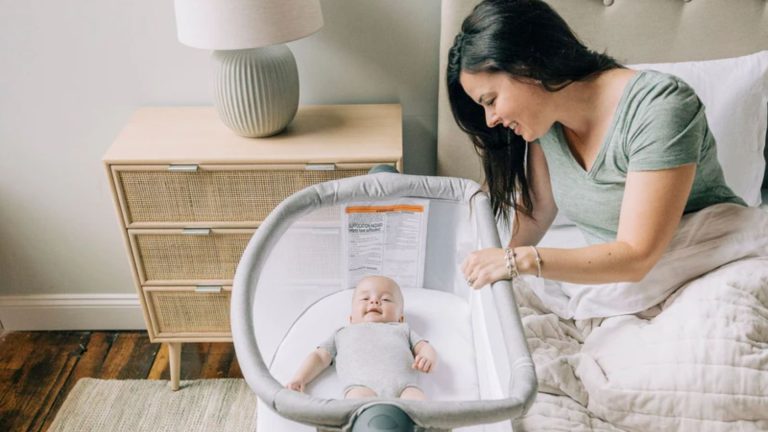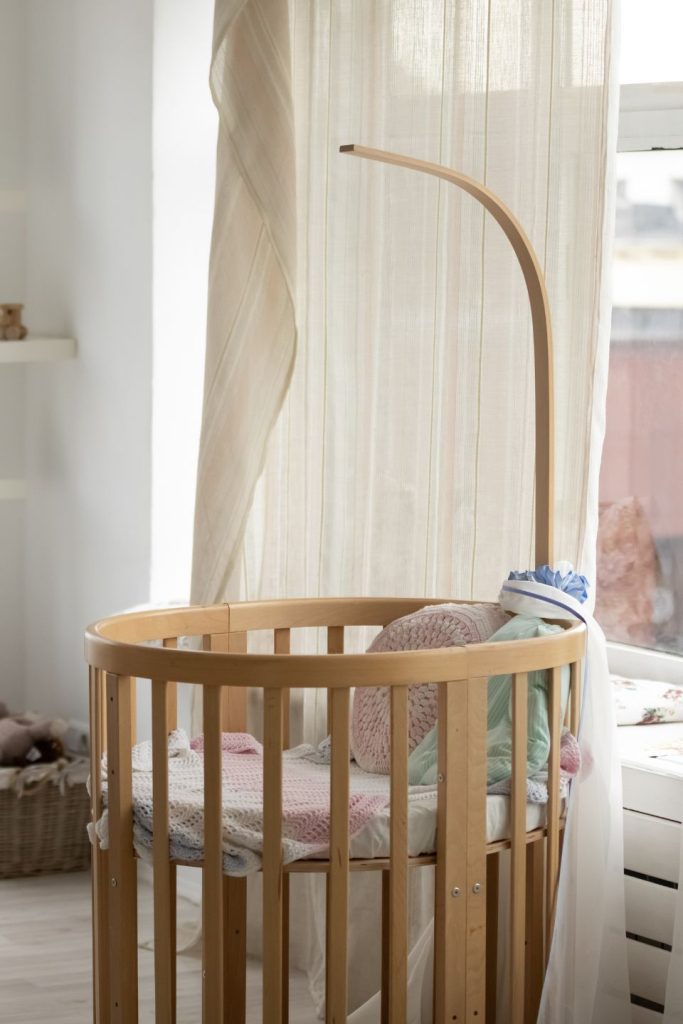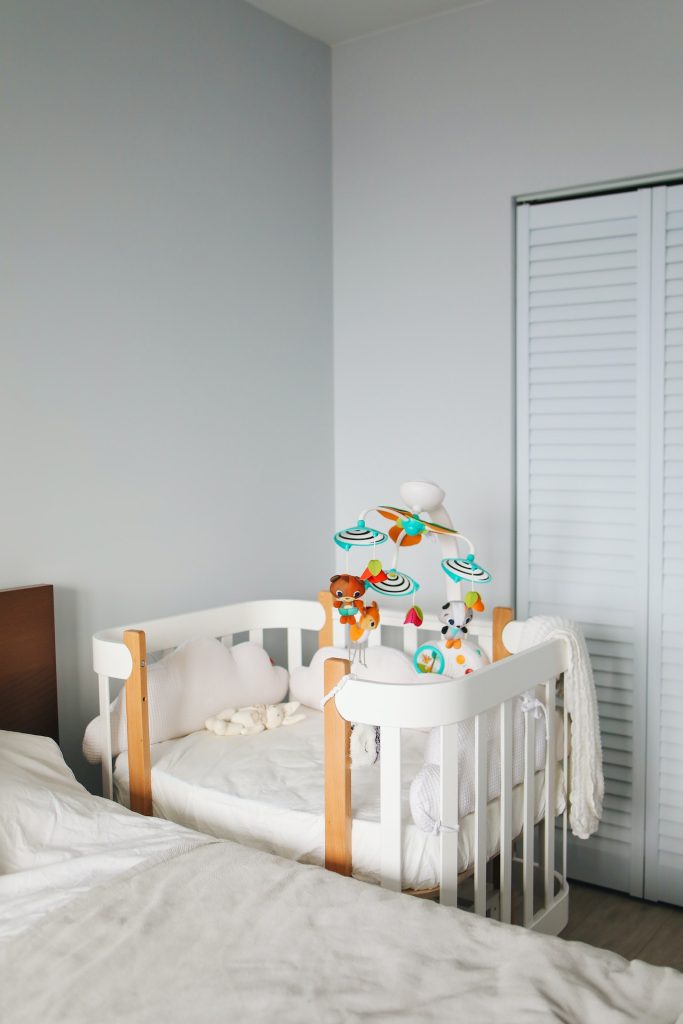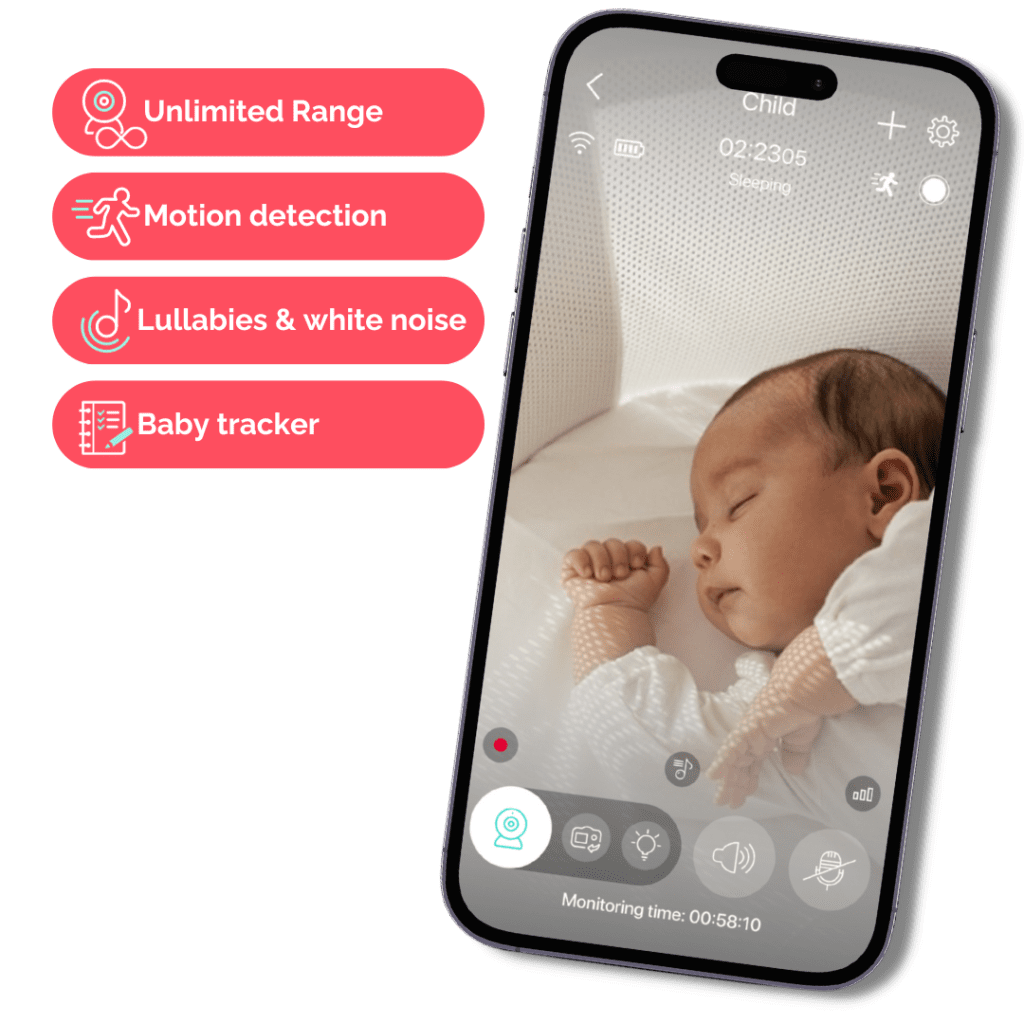
Bassinet vs Crib: Exploring the Best Sleeping Options for Your Baby
- Created:
1. 9. 2023 - Updated:
10. 1. 2024
Fact:
Decision-making can be quite challenging when providing a comfortable and safe sleeping space for your newborn.
As you weigh the pros and cons of all available options, it evolves into the ultimate showdown: bassinets vs cribs.
Both options have their merits, however:
Parents and caregivers need to understand the key differences to make a choice tailored to their baby’s sleep needs.
So:
Let‘s explore the similarities and differences to help you make an informed decision.
Ready?
What Is a Bassinet?

Get this:
Bassinets are specially designed, small sleeping spaces intended for newborns and infants. They often feature free-standing legs, a stationary frame or stand, and a wheeled or rocking base.
Bassinets are designed to have a sleep surface that is less or equal to 10 degrees from horizontal while in a resting position.
Now:
Bassinets are typically smaller and more portable than cribs. They offer a cozy and secure environment that mimics the feeling of being cradled.
They also provide a cozy environment for newborns, which simulates the feeling of being in the womb.
Additionally:
Some bassinets are designed to fit snugly next to the parent‘s bed, allowing for easy access to their newborns. This reduces nighttime disruptions and facilitates better sleep for the baby and the caregivers.
However:
Bassinets have weight and age restrictions. Parents should consider choosing models that meet safety requirements set by the US Consumer Product Safety Commission. This way, they can minimize the risk of accidents or injuries during use.
What Is a Crib?

Listen:
A crib is a specially designed baby bed, typically made of wood or metal. They provide safe and spacious sleeping spaces for infants and young children.
Cribs are more durable than bassinets, making them a long-term sleep solution. Also, they often last from infancy through the toddler years.
Now:
The most prominent feature of cribs is their size. Cribs offer ample space for babies to move, stretch, and eventually sit up or stand. Also, it ensures a comfortable and unrestricted sleeping environment as your child grows.
Now:
According to Consumer Reports, there are several factors that parents should consider when buying a crib for their baby. A properly fitted mattress prevents gaps that could pose sleep hazards for your child.
Furthermore:
There are federal regulations set in place to reduce these risks. MedlinePlus advises that parents and caregivers prioritize cribs that meet these safety standards. This ensures the well-being and safety of their babies.
Advantages/Disadvantages of a Bassinet
It’s no news:
When welcoming a newborn into the family, providing a safe and comfortable sleeping space is crucial for parents.
As such, bassinets have become popular due to their compact size and convenience. They offer numerous advantages that cater to the needs of babies and parents during the early stages of infancy.
Unfortunately, like any other baby gear, they come with their own set of limitations.
Understanding the pros and cons of bassinets helps parents make smart decisions when selecting the most suitable sleep solution for their newborn.
In this section:
We will explore the advantages and disadvantages of bassinets.
Additionally:
We will address the limitations of bassinets, including their limited lifespan, weight capacity, and the need to transition to a crib as the baby grows.
Ready?
| Pros | Cons |
|---|---|
| Bassinets are lightweight and compact. Its portability and mobility make them easy to move from room to room or even take along when traveling. | Bassinets have weight and size restrictions. It has limited time usage, so it can’t be used for as long as cribs. Bassinets are unsuitable for babies that can roll over or push up on their hands and knees. |
| Bassinets are space efficient. They are ideal for families with limited living space or those who want to sleep in the same room as their infant. | While co-sleeping bassinets are designed for safety, they still pose a potential risk of accidental suffocation. According to the American Academy of Pediatrics (AAP), co-sleeping raises the risk of sudden infant death. |
| Most bassinets have soothing features that mimic gentle motions, similar to being held or rocked. These features can help calm a fussy baby and facilitate healthy sleep patterns. | Bassinets are not advisable for active sleepers. Some babies can be active during sleep and may find the confined space of a bassinet uncomfortable. Restless sleepers might wake up more frequently, making it challenging for parents to get sufficient rest. |
| The mesh sidewalls of bassinets are breathable and transparent. It helps enhance ventilation and reduce the risk of suffocation. | While bassinets often come with basic features, such as a mattress and a canopy, cribs offer more versatility. Bassinets are cheaper than cribs. However, once your baby outgrows the bassinet, you may need to invest in a crib, making the bassinet less cost-effective in the long run. |
| Bassinets are designed with features that make your baby’s transition from the womb to the bassinet smooth and comfortable. This supports healthy sleep habits from an early age and helps alleviate the complications that arise from sleep regressions. | When the baby outgrows the bassinet, transitioning them to a crib or their room can be difficult and may disrupt their sleep routine. Parents must prepare for this transition to minimize any potential sleep disturbances. |
Advantages/Disadvantages of a Crib
Admittedly:
Cribs are sturdy and versatile. They offer a range of advantages that make them an appealing choice for families seeking a reliable and long-term sleep solution.
But as with any choice, there are advantages and disadvantages to consider. Let’s get to it!
| Pros | Cons |
|---|---|
| Cribs are built to withstand the test of time. They are constructed from sturdy materials such as wood or metal and offer exceptional durability. This ensures they remain a safe and reliable sleeping space for your child as they grow. | Cribs require assembling, which can be time-consuming and may require a degree of professionalism. Parents need to ensure that they check for loose or broken parts regularly. |
| Unlike bassinets, a crib can accommodate your child for several years. Many cribs come with adjustable mattress heights that allow you to raise or lower the mattress as your baby grows. | Cribs are larger than bassinets and demand more floor space. This can be a challenge if you have limited living space, as you need to find a suitable area in the bedroom or nursery to erect the crib. |
| Cribs offer a comfortable and secure sleep environment for babies. The mattresses in cribs are usually firm, thus promoting safe sleep and reducing the risk of Sudden Infant Death Syndrome (SIDS). Also, some cribs come with teething rails, storage drawers, and convertible options. | As babies grow older and more active, they start to pull themselves up to a standing position or attempt to reach the top railing. This poses a risk of falling from a height that could lead to injuries. |
| Cribs provide ample space for your baby to move around, stretch, and sleep comfortably. The larger sleeping area supports unrestricted movement, providing a sense of freedom as your child develops essential motor skills. | Cribs are less portable than bassinets. This makes them less convenient for parents who travel frequently or want to move the crib between rooms. |
| Sleeping in a separate crib from an early age encourages independent sleep habits in infants and minimizes separation anxiety. As your baby becomes more accustomed to their sleeping space, they are more likely to develop a healthy sleep routine. | Cribs are more expensive compared to bassinets. They often come with higher upfront costs, especially if you opt for cribs with extravagant features. |
Factors to Consider
Admittedly:
Both options offer distinct advantages, each catering to the unique needs and preferences of parents and their newborns.
But:
When choosing between a bassinet and a crib, the best decision for your family and newborn is determined by different factors like budget and living space.
Thus, parents must be aware of these factors to consider when making a choice. Some of these include:
1. Budget
First off:
An important factor in the decision-making process is your budget.
Typically:
The cost of basic bassinets ranges from $50 to $200, but more complex or designer bassinets can cost up to $400.
Meanwhile:
The cost of a baby’s crib can be anywhere between $100 to $500. Convertible cribs (those that convert into toddler beds or full-size beds) cost between $200 and $800 or more.
It all comes down to this:
Bassinets are generally more affordable than cribs, making them an attractive option for budget-conscious parents.
Nevertheless:
Cribs offer long-term usability and a more cost-effective investment in the long run.
2. Living Space
Another crucial factor to consider is the size of your living space. Essentially, the available room in your home determines if you’d opt for a crib or bassinet.
Bassinets, being compact and lightweight, are well-suited for smaller living spaces, while cribs can be considered for ample spaces.
3. Usability Period
Understanding the duration of usability is essential in making an informed decision.
Bassinets have limited usage; they can accommodate newborns up to six months or until your baby starts to roll or push up.
In contrast:
Cribs can accommodate infants and toddlers for several years. This extended period of use eliminates the need for a bed change as your baby grows.
4. Safety
It’s no news:
Safety is paramount when you’re deciding between cribs or bassinets.
Parents must prioritize the safety of their baby by ensuring that both the bassinet and crib meet safety standards. The Centres for Disease Control and Prevention (CDC) advises that you opt for models that meet federal requirements to prevent sleep hazards.
So:
Ensure you have secure constructions and follow the manufacturer’s installation and maintenance guidelines.
5. Personal Preference
Obviously:
Personal preferences and parenting styles also come into play.
Some parents may feel more comfortable having the baby sleep in a bassinet and close to their bed during the early months. This promotes bonding and easy access to nighttime care.
Others may prefer the sense of independence and long-term value that cribs offer.
Note:
Regardless of your personal preference, it is crucial to create an ideal sleep environment for your child. Make sure to establish a setting that encourages peaceful sleep and general well-being.
Final Tip: Annie Baby Monitor – Your Watchful Companion in the Nursery
Watching over your little one when they start sleeping on their own is important.
You can easily do that by placing a monitor in their nursery. With Annie’s real-time video and audio monitoring, as well as cry and motion detection, you can always stay connected with your child, which will give you peace of mind and give you peace of mind.

Looking for a top-notch baby monitor? Look no further than Annie Baby Monitor. It’s the perfect solution for keeping tabs on your little one. Check it out now.
Conclusion
Let’s summarize:
Choosing between a bassinet and a crib is a significant decision for parents seeking the best sleep option for their newborn.
Now:
Considering key factors such as budget, living space, and personal preferences can help parents make an informed choice.
Ultimately:
The goal is to create a safe and comfortable sleep haven that aligns with your baby’s sleep routine. But before you make a decision, there are a few differences you should be aware of:
- Cribs are larger and more stationary, while bassinets are known for being compact and portable.
- Cribs provide long-lasting functionality by adapting to your child’s growth. In contrast, bassinets are appropriate for babies above six months of age.
- Bassinets are more affordable than cribs, making them a budget-friendly option for families.
And that’s a wrap!
If you have any concerns or questions about choosing between a bassinet and a crib for your baby’s sleep, it is essential to seek guidance from your pediatrician or a child sleep specialist.
Consulting with an expert ensures that you prioritize your baby’s safety, comfort, and overall well-being.
Finally:
I believe this article has provided you with valuable insight into choosing between a bassinet and a crib. Feel free to share your thoughts in the comment section, and don’t forget to leave your questions if you need some clarity.
FAQ: Bassinet vs Crib
The main differences between a bassinet and a crib are size, mobility, and duration of usage. Bassinets are typically smaller and more portable, making them suitable for newborns. On the other hand, cribs are larger, less mobile, and offer longer-term usability, accommodating babies as they grow into toddlers.
To decide between a bassinet and a crib for your newborn, consider your living space, budget, and baby’s needs. A bassinet may be more suitable if you have limited space or want your baby close to you during the early months. Alternatively, a crib is a practical choice if you prefer a better long-term investment, greater durability, and adjustable features.
Yes. Ensure both options meet the required safety standards and have sturdy construction with no sharp edges or loose parts. For bassinets, ensure it has a firm mattress and proper ventilation. Also, check for correct assembly and appropriate slat spacing for cribs. Lastly, avoid using pillows, blankets, or soft bedding to reduce the risk of Sudden Infant Death Syndrome (SIDS).






